
Posted on 02/19/2005 12:35:54 PM PST by BroncosFan
ARMED FORCES OF THE WORLD: The Mighty Japanese Navy
February 19, 2005: The JMSDF (Japanese Maritime Self-Defense Force) is arguably the second-best navy in the Pacific, trailing only the United States Navy. The JMSDF has a large number modern surface combatants and the third-largest submarine force among Pacific naval powers, and it could be a potential player in any fight across the Formosa Strait due to the fact that Japan’s ties with Taiwan have become much closer.
The primary surface vessels in the JMSDF are the destroyers. Japan’s had a long tradition of building a superb destroyer force – in World War II, their destroyers were arguably the best in the world. The best destroyers in the JMSDF are the Kongo-class DDGs. These 7,250-ton ships carry 90 vertical-launch cells for SM-2MR missiles (with a range of 111 kilometers), and are equipped with the Aegis system. They are, in essence, copies of the Arleigh Burke-class destroyers in U.S. Navy service, with a few small exceptions (no Tomahawk capability, an Italian 5-inch gun, and some Japanese electronics). It is probably the best surface combatant outside the United States Navy. Japan also has a smaller force of older guided-missile destroyers, the Hatakaze and Tachikaze classes. These two destroyer classes are roughly equivalent to the Charles F. Adams-class destroyers. Japan also has four helicopter-carrying destroyers, primarily used for anti-submarine warfare.
Two other modern destroyer classes are entering service: The Murasame (4,550 tons) and Takanami-class (4,600 tons) destroyers both have vertical-launch cells, but both primarily focus on anti-submarine warfare. They usually carry a mix of vertically-launched ASROC and Sea Sparrow missiles. The two ship classes will comprise fourteen ships total. The major difference between the two ship classes are their main guns. The Murasame has a 76mm gun, the Takanami, a 5-inch gun. Two other classes of destroyer, the Asagiri and Hatsuyuki are also present in strength (20 ships between the two of them).
Japan’s other major asset is its large force of advanced diesel-electric submarines (eighteen subs). The Yuushio, Harushio, and Oyashiro classes displace anywhere from 2,450 tons to 3,000 tons. Each carry six 21-inch torpedo tubes, with a total of 20 weapons (either Harpoon anti-ship missiles or Type 89 torpedoes). These subs would be a potent force against the Chinese Navy.
The JMSDF has some problems. Training is difficult, since Japan’s waters have many commercial fishing and merchant vessels. Japan is usually able to squeeze in only about ten days of training for mine warfare, when fishing is not so good. The JMSDF also is short on underway replenishment vessels – a total of four such ships are available to refuel forty-seven destroyers. The new submarines have also been expensive ($500 million apiece), a problem when the Japanese Constitution limits defense spending to one percent of Japan’s Gross National Product. Similarly, the Kongos were built to mercantile standards to save money – which means they cannot take as much damage as a Burke-class destroyer. Furthermore, Japan’s efforts to build an aircraft carrier have run into opposition. The official design for the replacement for the Haruna and Shirane-class DDHs have shown a full superstructure and forward and aft helicopter pads. However, alternative designs have looked like a small aircraft carrier. At 13,500 tons, these are not much smaller than an Independence-class light carrier from World War II.
The JMSDF also has problems with political support. Often, Japan’s security needs (such as the ability to protect oceangoing trade) have been subordinated to concerns about whether a posture is too aggressive. This has gone back to 1981, when proposals to ensure defense of sea lanes was controversial – despite Japan’s experience under submarine blockade in World War II. Also, Japan’s had problems getting sufficient personnel – it has been under authorized strength in the past (a shortfall of 3.5 percent existed in 1992). Ultimately, Japan’s ability to overcome the political issues and to get an adequate number of trained personnel will determine how well it can carry out its mission of defending Japan. – Harold C. Hutchison (hchutch@ix.netcom.com)
Bump..
No picts? I wanted to see fish swimming out of their portholes!
Bump..
Do you post articles of this sort (asia-pacific military matters)? If you do, please put me on your ping list.
agreed........he knows which side his sushi is buttered on...I heard a great critique on the Chinese Navy by that ambassador turned Fellow at a righty think tank.......he basically said they have numbers but are really crap on the seas and haven't had a major engagement on the oceans since one of those long ago dynasty's......said the U.S. could take them in a matter of weeks easily......
I actually tried to remember the last time the Chinese Navy had a victory, and couldn't think of one offhand.
The last time they saw combat was being crushed by the Japanese in 1895.
What you heard from the ambassador conforms to what I've heard from various naval types; including some that have been on PRC warships; they look pretty "sloppy."
True for now, IF we have the will, IF we're not distracted elsewhere, IF it isn't already over by the time we arrive on scene in sufficient numbers, IF we don't get dissuaded by a few early setbacks. The center of gravity lies in Foggy Bottom, not in the Straits. Remember, the Falklands didn't start off well at all for the Brits. They lost the islands, lost the Sheffield and other picket destroyers, and took several weeks to get in the game. How will we react if things unfold in a similar manner? Especially if there's a new Democrat president. And what if we're tied up in Venezuela or Iran?
that is alot ofr "if's".....just talking about the comparison of the arsenals at sea and how we logistically we could take those little guys all things being equal
plus I heard that their primary missles and such were just not on par though their ships are fairly modern......I'll bet not a whole lot better than Russia in the later stages of their arms race...

One Clinton legacy we need to be grateful for is the rearming of Japan. Before Clinton came on the scene, Japan largely entrusted their protection to the U.S. military. Once it became clear that Clinton was owned by the ChiComs, Japan was morivated to build a military worthy of the world's second biggest economy.




The way Clancy had the Japanese navy disable two nuclear carriers and sink a US sub in Debt of Honor was actually believable. And then the turnabout when we got our own back was a great exercise in how we would answer asymmetric warfare, as long as we could identify who the bad guys were.
You missed the big 'if': IF the Chinese don't shut down the US retail economy by embargo.




The way Clancy had the Japanese navy disable two nuclear carriers and sink a US sub in Debt of Honor was actually believable. And then the turnabout when we got our own back was a great exercise in how we would answer asymmetric warfare, as long as we could identify who the bad guys were.

Launch of SeaSparrow
"PG launching SSM"
5 inch caliber rapid fire
Submarine Tender "CHIYODA"
UH-60J rescue helicopter
EP-3 multipurpose aircraft
SH-60J training submarine searching operations
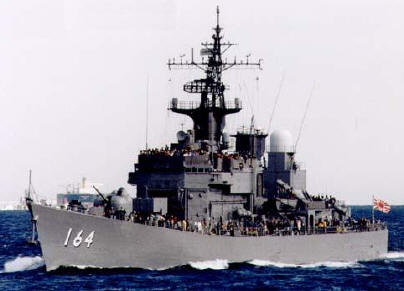
In 1967, at the Ishikawajima Harima Shipyard, this obsession of loading their largest destroyer "to the teeth" was seen in the TAKATSUKI class destroyer (seen at left). While only 3100 tons standard, the TAKATSUKI class destroyer had the same weaponry that U.S. Destroyers of double the tonnage would contain including 3-aircraft DASH capability, ASROC with reload capability, Weapon Alpha as well as two MK-32 Triple Torpedo tubes and one four-tube BOFORS ASW launcher. Yet, while this ASW obsession-philosophy even reached down to smaller Japanese torpedo boats which were equipped with dipping sonars, sonobuoys as well as ASW torpedoes, the threat from the air was relatively ignored using only obsolete 3-inch/50 caliber guns. This was due to the overriding mission being to keep the sea-lanes clear of submarines as Japan imported almost all of the raw materials its economy required and still does. Even though the new Japanese Maritime Self-Defense Force had become by 1970, the 10th most powerful Navy in the World -end snip-
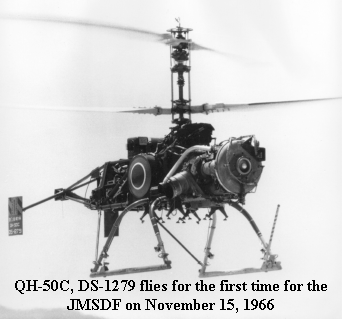
When the U.S. Navy's DASH program was in full operation, the U.S. Navy loaned the Japanese Maritime Self-Defense Force (JMSDF) three QH-50C drones under the Military Assistance Program (MAP) and sold the JMSDF a single D model aircraft in 1965 to see if DASH could bolster the JMSDF's ASW capabilities. The C model serial numbers were DS-1278, DS-1279 and DS-1280. The D model was DS-1494.
With a dual torpedo delivery capability in any weather, a 45 mile delivery range and the close proximity to Soviet Union (USSR) Naval Bases, the Japanese were very interested in the DASH concept. After testing, the JMSDF purchased 16 additional aircraft from Gyrodyne in 1967 (All D models) through the Nissho-Iwai Trading company, with the final delivery in September 1971. They were serial numbers J-1 through J-16. Above left, QH-50C, number DS-1279, flies for the first time on November 15, 1966 from the training base at Eta Jima, Japan; the JMSDF training facility. By March 31 1971,The JMSDF had flown over 1,440 hours. By September of 1971, SEVEN Japanese Destroyers were flying DASH, with a success rate of 360 hours mean time before failure (MTBF) which was twice the U.S. Navy's over-all record. Yet this success was not by accident. 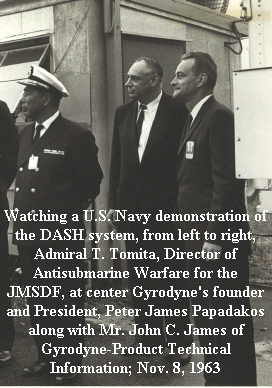
The Japanese success with their DASH program can be seen in the different manner in which the JMSDF managed their DASH program. The primary difference was the length of time the JMSDF personnel stayed with the program. Capt. Robert H. Beyer USNR (ret), Gyrodyne's then Director for International Operations, who worked with the JMSDF for over six and one half years, stated that personal whom he knew in 1966 were still with the program in 1971. Compare this to the U.S. Navy it was not at all unusual to have a DASH Officer "come and go" through a specific DASH command within six months. Further, there were instances on U.S. Naval destroyers where the senior enlisted man in a DASH group was a 3rd class Petty Officer. The Japanese treated their DASH operation with much more prestige as the commanding Officer of the Training School was a full Captain with full commanders as maintenance and training officers. As far as assignments on Ship, further distinctions were seen. In the U.S. Navy program, the DASH group was comprised of one officer and four enlisted men. Of the 4 enlisted men, at least two in the billet had aviation ratings yet all in the billet were assigned regular shipboard duties with their DASH assignment considered secondary or collateral as the needs of the ship determined priority.
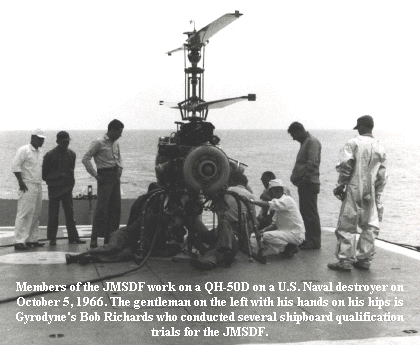
On a JMSDF destroyer, DASH assignments were considered primary duty with other shipboard assignments considered collateral. Further, Japanese technicians would meticulously wash and wax all drones before returning them to their hangars. Capt. Beyer stated that, "When you looked at a Japanese bird, it looked like it just came from the factory -even though it might be three years old. By contrast, I've been aboard some U.S. Destroyers whose birds had corrosion like icicles!". In fact, the U.S. Navy's CRUDESPAC (Commander, cruisers, destroyers-pacific fleet) instituted a program to remove DASH drones and have the them decontaminated by a Japanese contractor (Shinmewa Industries).
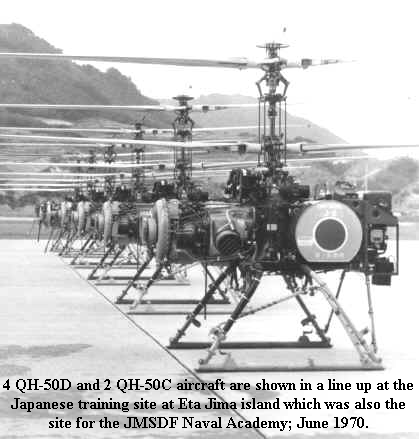
-end snip-
http://www.gyrodynehelicopters.com/jmsdf_destroyers.htm
Are we playing the "Japan Card" to stop China from saber rattling?
The last PLAN victory was more recent than that.They had a series of clashes with the Vietnamese navy in the 1980s & a pretty big one in 1988,when they sank a handful of Vietnamese gunboats.
Disclaimer: Opinions posted on Free Republic are those of the individual posters and do not necessarily represent the opinion of Free Republic or its management. All materials posted herein are protected by copyright law and the exemption for fair use of copyrighted works.